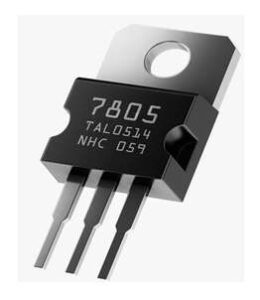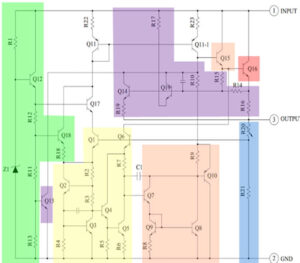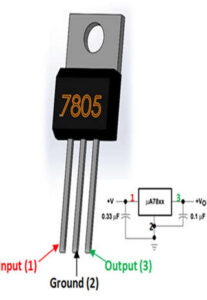- The voltage regulator IC 7805 belongs to the 78xx series of voltage regulator ICs. It is a linear voltage regulator with a fixed output voltage. The xx in 78xx represents the value of the fixed output voltage provided by the specific IC.

- Because of circuit fluctuations, no voltage source can provide a constant output. Voltage regulators are used to achieving a constant and steady output. Voltage regulator integrated circuits (ICs) are integrated circuits that are used to regulate voltage.
Here we certainly need to understand what is a voltage regulator and how it works.
- A voltage regulator produces a fixed output voltage of a predetermined magnitude that remains constant regardless of input voltage or load conditions. Voltage regulators are classified into two types: linear and switching.
- A linear regulator is comprised of an active (BJT or MOSFET) pass device (series or shunt) that is controlled by a high gain differential amplifier. It compares the output voltage to a precise reference voltage and adjusts the pass device to keep the output voltage constant.
- A switching regulator converts an alternating current input voltage to a switched voltage that is applied to a power MOSFET or BJT switch. The filtered power switch output voltage is fed back to a circuit that controls the on and off times of the power switch, ensuring that the output voltage remains constant regardless of input voltage or load current changes.
- Coming back to the 7805 voltage regulator IC.
- Lots of energy is lost as heat in the IC 7805 voltage regulator. Heat is produced by the difference between the input and output voltage values. As a result, if the difference between the input and output voltages is large, more heat will be generated. This excessive heat will cause a malfunction in the absence of a heat sink.
What to do with all the heat?
- The 7805 voltage regulator is inefficient and has drop-out voltage issues. A significant amount of energy is lost as heat. If you’re going to use a heatsink, make sure the heatsink size is correct. The formula below should assist in determining the appropriate heatsink size for such applications.
- Heat generated = (input voltage – 5) x output current
If we have a system with input 15 volts and output current required is .5 amperes, we
have: (15 – 5) x 0.5 = 10×0.5 =5W;
5W energy is being wasted as heat, hence an appropriate heatsink is required to
disperse this heat. On the other hand, energy being used is:
(5 x 0.5Amp) = 2.5W.
So twice the energy, that is utilized is wasted. On the other hand, if 9V is
given as input at the same amount of load: (9-5) x 0.5 = 2W
2W energy will be wasted as heat.
Block Schematics of IC 7805 Voltage Regulator
- The 7805 IC’s heart is a transistor (Q16), which controls the current between the input and output, and thus the output voltage. The bandgap reference (yellow) maintains voltage stability. It receives the scaled output voltage as input (Q1 and Q6) and outputs an error signal (to Q7) indicating whether the voltage is too high or too low. The bandgap’s primary function is to provide a stable and accurate reference even as the temperature of the chip changes.

- The error amplifier amplifies the error signal from the bandgap reference (orange). Through Q15, this amplified signal controls the output transistor. This completes the negative feedback loop that regulates the output voltage.
- The startup circuit (green) supplies initial current to the bandgap circuit, preventing it from becoming stuck in an “off” state. The purple circuit protects against overheating (Q13), high input voltage (Q19), and high output current (Q14). In the event of a fault, these circuits reduce the output current or shut down the regulator, protecting it from damage. The voltage divider (blue) reduces the voltage on the output pin so that the bandgap reference can use it.
Pin Configurations
The pin diagram of the 7805 Voltage regulator is given below.

-
- Input – Unregulated Input Voltage.
- Ground – Connected to Ground.
- Output – Outputs Regulated +5V.
Features of 7805 Voltage Regulator
- Maximum output current is 1.5A.
- Protection against internal thermal overload.
- Capability for High Power Dissipation.
- Limitation of internal short-circuit current.
- SAFE-Area Compensation for Output Transistor.
Applications of 7805 Voltage Regulator
- Dual-supply regulation.
- Creating circuits for phone chargers, UPS power supply circuits, portable CD players, and other devices.
- Regulator with a fixed output.
- Adjustable output regulator.
- Current regulator.
